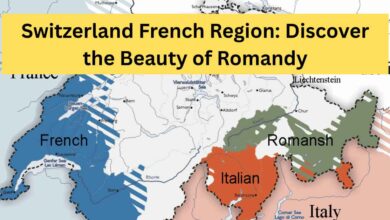Best Swiss Mountain Lakes – Stunning Alpine Gems

The nearest lake is never more than 16 kilometres (10 miles) away, regardless of your location in Switzerland. The water fortress of Europe, Switzerland, is a diminutive country that boasts an impressive total of more than 1,500 lakes.
That is certainly an excessive number of destinations to attend during your stay, necessitating that you prioritise. However, which ones are best? Are there any that you simply cannot overlook?
I apologise for the disappointment, but asserting that I possess the definitive list of the most stunning must-see lakes in Switzerland would be exceedingly presumptuous. Therefore, I will refrain from visiting that location.
Nevertheless, in an effort to accurately represent our lakes, I will provide a summary of my personal favourites that I am confident will captivate you.
Are you prepared to take the plunge?
Scenic View of Lake and Mountains:
1. Oeschinense
People from all over the globe are drawn to the deep blue waters of Oeschinensee. The lake can be accessed by either foot or cable car.
What’s the deal?
One of Switzerland’s largest mountain lakes is this turquoise wonder located in the Kander Valley. Oeschinensee, a UNESCO world heritage site, is 1.6 kilometres (1 mile) in length and can reach a depth of up to 56 meters (183 feet).
People from all over the world are drawn to the incredibly blue water and the impressive mountain panorama in the backdrop. Consequently, the shores can become quite crowded on a sunny day. Nevertheless, if you depart from the primary area surrounding the restaurant and continue along the lake, it is probable that you will locate a tranquil location.
The water in Oeschinensee is sourced from the glaciers in the vicinity, resulting in a revitalising experience that is consistent throughout the year. The temperature of the water rarely exceeds 20°C (68°F), even during the summer.
Check Also: Complete Jungfraujoch Travel Guide – Things to Do
What’s there to do?
It is nearly mandatory to embark on a walk in Oeschinensee, as it is enveloped by towering mountains. However, swimming, picnicking, renting a canoe to demonstrate one’s rowing abilities, and swooshing down a mountain coaster are also popular activities. However, the rowing and mountain coaster are exclusively accessible during the summer.
Hiking in the Oeschinensee region is highly beneficial.
How do you get there?
First, you must travel to Kandersteg in order to visit Oeschinensee. Trains depart from Bern every hour, and it is also feasible to travel to Kandersteg from Interlaken with an additional transfer in Spiez.
To reach the lake from Kandersteg, you may either hike (approximately 1.5 hours) or ride the gondola. I suggest purchasing your gondola ticket online in order to bypass the ticket counter queue.
Upon reaching the summit, the shores of Oeschinensee are a mere 20-minute stroll away. Take in the scenery.
2. Blausee
It is no surprise that this lake is referred to as “Blausee” (blue lake). The clarity of this lake is such that it is possible to observe the bottom.
What’s the deal?
This lagoon is blue, as its name implies. Absurdly aquamarine…
Little Blausee is more readily accessible than Oeschinensee, as it is situated in the heart of an idyllic nature park in the Kander Valley. No gondola ride or trekking is necessary; a brief stroll from the lake’s entrance suffices. While this may be advantageous, it also leads to thousands of individuals arriving daily to catch a glimpse of this pearl.
The park’s charm is regrettably diminished by the fact that it receives up to 4,500 visitors on a busy day, despite the fact that the area is not particularly expansive. Nevertheless, in my view, the lake’s grandeur compensates for some of the shortcomings.
What’s there to do?
If you are interested in travelling across Blausee on a glass-bottom boat, you are in luck. The park’s entrance charge, which fluctuates seasonally between 5 and 10 CHF, includes a brief journey across the lake in a small rowing boat with a transparent floor. Additionally, the lake’s floor will be visible due to the exceptionally clean water.
Furthermore, the region is home to numerous picnic areas, fireplaces, walking trails, a few alpacas, and a trout farm. The area is limited and enclosed, so hiking is not a common activity. However, if you are seeking a leisurely Sunday stroll and maybe a few Instagram-worthy photos, this location is ideal.
How do you get there?
The bus stop Blausee BE, situated between Kandersteg and Frutigen, serves as the beginning point for your exploration of Blausee. Buses depart from Kandersteg and Frutigen on an hourly basis and transport passengers directly to the entrance of the nature park.
3. Lauenensee
The Bernese Alps are the location of Little Lauenensee. Even the Swiss band “Span” composed a tune about this lake.
What’s the deal?
It is probable that individuals will begin singing whenever Lauenensee is mentioned in Switzerland.
A song about this stunning mountain lake was published by the Swiss band “Span” in 1983. Its melancholic lyrics and appealing melody have remained ingrained in the minds of individuals ever since. The lyrics and notes of the melody are also available on a board located near the lake’s edge.
One peculiar aspect of Lauenensee is that it is actually composed of two lakes. They are both relatively diminutive and are separated by a narrow tract of swamp. Lauenensee experiences significantly higher temperatures than one would anticipate for a mountain lake, as a result of its shallowness.
What’s there to do?
Despite the fact that Lauenensee is a) situated in a natural reserve and b) extremely shallow, it is still possible to swim. A pier extends a few meters into the lake, traversing the marsh. Alternatively, if you prefer to remain on the water, you may charter a boat from the restaurant during the summer.
The lake is encircled by the stunning Bernese Alps, making it an ideal location for a walk. Additionally, fireplaces are present in the vicinity. It takes approximately 45 minutes to walk around the lake.
How do you get there?
Lauenensee is somewhat remote, as is the case with the majority of mountain lakes. The Golden Pass Line from Lucerne or Interlaken to Montreux will take you through Gstaad, which is the optimal starting point.
Postauto is the most convenient method of transportation to the lake from Gstaad. However, those yellow vehicles that are so recognisable are only operational during the summer.
Hiking to the lake in its entirety or a combination of hiking, cable car, and Postauto journeys is also feasible. Please refer to the tourism website of Gstaad in order to organise your journey accordingly.
4. Seealpsee
One of my preferred mountain lakes in Switzerland is Seealpsee, which is situated in the Alpstein mountain range. Its water is not always as frigid as it appears.
What’s the deal?
Seealpsee would not be in competition with many other mountain lakes if I were required to select a preference among the numerous ones that exist.
I was essentially reared in the vicinity of that entity, as I was born and raised in eastern Switzerland. Not that I enjoyed ascending to that location, mind you. Hiking was nearly my least favourite pastime. The second most popular activity is visiting museums.
However, it is impossible to surpass Seealpsee when one is raised in the Appenzell region. A challenging existence…
The majority of individuals are familiar with Seealpsee due to its appearance on the label of the popular lager brand Quöllfrisch. Alternatively, if you have ever conducted a search for the renowned Äscher restaurant, you may have observed the lake subtly situated in the backdrop.
What’s there to do?
The most obvious activities up here – as with pretty much every mountain
lake – are hiking, swimming or rowing around in a rental boat. And since walking uphill for an hour has a tendency to make people hungry, I highly recommend you visit one of the little Alp huts to buy some fresh milk or cheese for your picnic.
I never leave the Alpstein mountain range without grabbing a loaf of soft goats cheese. And neither should you…
You never know who you might bump into in the Alpstein mountain range.
How do you get there?
To visit Seealpsee, travel to Wasserauen in the Appenzell region. It requires some time to reach the destination, and you will be passing through St. Gallen or Gossau, a municipality located just outside of St. Gallen, regardless of your location in Switzerland.
If the Äscher restaurant is also on your bucket list, you can incorporate the two destinations in a single hike. Begin your journey in Wasserauen and either take the gondola to Ebenalp, hike past Äscher to Seealpsee, and return to Wasserauen. Alternatively, one may commence the hike and reserve the gondola trip for the conclusion.
While hiking the entire distance is somewhat more taxing, it is also feasible. The cycle should be completed in approximately 4.5 hours. Give or take. For additional information regarding treks in the Alpstein mountain range, consult the tourism website of Appenzell.
5. Fälensee
Fälensee is one of the three lakes in the Alpstein. The journey to Fälensee necessitates a significant amount of trekking.
What’s the deal?
Fälensee’s enigmatic quality consistently evokes the image of a Scottish loch immediately following a tempest. You would almost anticipate Nessie to emerge from the water and enquire about the weather forecast, as the dark water reflects the grey clouds that are descending the mountains.
Fälensee is an additional pearl that renders the perspiration you have shed on your ascent worthwhile when the sun is shining.
What’s there to do?
Fälensee is the least accessible of the three lakes in the Alpstein mountain range, necessitating a three-hour walk. Or 2.5 hours if you are accustomed to ascending.
It is also possible to take a swim; however, the descent to the shore is more difficult than it is at Seealpsee due to the swiftly rising mountains on either side. Nevertheless, it is still feasible, and access is significantly improved if one continues to follow the lake to Fälenalp on the opposite side.
By the way, Fälenalp is an exceptional location to indulge in a picnic consisting of fresh milk, cheese, and bread. Alternatively, one could spend the night in a stable that is situated above the cows. Depending on your level of resistance to the unpleasant odour of cowshit.
How do you get there?
Additionally, it is necessary to travel to eastern Switzerland in order to visit Fälensee. Or, to be more precise, to Brülisau. This entails a few Postauto travels and train rides, contingent upon the location from which you commence your journey in Switzerland. Your optimal connection will be displayed on the SBB website.
Alternatively, you may take the gondola to Hoher Kasten from Brülisau and commence your walk from there. It will require four hours to arrive at Bollenwees, the restaurant situated adjacent to the lake. Alternatively, if you opt to bypass the gondola and proceed directly from Brülisau to Bollenwees, the journey will take approximately 2.5 hours.
Once more, the tourism website for Appenzell will assist you in organising your journey.
6. Caumasee
In the Grisons Alps, Caumasee is known as an immaculate pearl. It is a favoured destination for both locals and tourists to unwind on a sunny day.
What’s the deal?
Caumasee is a breathtaking alpine lake located in the Grisons Alps, not far from Chur. It is encircled by a pine forest and features a small island in its centre.
The local language’s original name for the lake, Lag la Cauma, translates to “lake of siesta.” Therefore, the tranquil environment of the Cauma region is unlikely to startle you.
Caumasee is comparatively warm in comparison to other mountain lakes. The water temperatures in the summertime are between 19°C and 24°C (66°F – 75°F), which is higher than any of the glacier-fed mountain lakes.
What’s there to do?
The possibilities for activities at Caumasee are apparently limitless.
In addition to the standard activities of hiking and swimming, visitors may also engage in stand-up paddling, rent a paddleboat, play beach volleyball, launch themselves off the diving platform, or relax in the Botanic Lounge at the Caumasee restaurant.
The recreational beach is accessible for a fee of 15 CHF from May to October. For additional details regarding Caumasee, please consult the Flims Laax Tourism website.
Visitors are required to remain behind the fence in order to access the lake without paying admission. In that location, you will have the opportunity to stroll around half of the lake and appreciate the scenery without the presence of any infrastructure.
How do you get there?
Travelling by public transport, proceed to Chur and board the Postauto to Flims Waldhaus. From there, it is an additional 30 minutes to Caumasee or 15 minutes to the lift that descends to the lake from June to August.
The Senda Ruinaulta is a walk that I strongly recommend in the vicinity. Ruinaulta, the Rhine Gorge, and Caumasee are all accessible via a straightforward three-hour walk that also passes through Ruinaulta. This UNESCO world heritage site, which is also referred to as the Swiss Grand Canyon, never fails to captivate.
Switzerlandmobil’s website contains additional details regarding this excursion. Additionally, if you are an avid cyclist, you may rent a bicycle in Flims and experience the region on two wheels.
7. Crestasee
Crestasee is situated in close proximity to Caumasee. The Swiss Grand Canyon, also known as Ruinaulta, is visible during the trek between Caumasee and Crestasee.
What’s the deal?
Lag la Cresta, which translates to “lake by the forest ridge,” is another picturesque mountain lake located not far from Caumasee.
Crestasee is smaller than Caumasee, yet it exudes the same appeal as its larger neighbour. The lake’s floor is visible due to its crystal-clear water, which also reflects the surrounding landscape in a stunning manner. You are likely to be unable to stop gazing or taking photographs, as is the case with any other mountain lake.
What’s the deal?
The activities at Crestasee are not significantly different from those at Caumasee. Rent a rowing boat or stand-up paddleboard, take a swim, or simply relax by the lake. You have the freedom to make a decision. During the summer, it is feasible to access the bathing shore for a fee of 7 CHF.
By the way, it would be a pity to miss out on a walk while you are in the area. The one that I suggest is a combination of Crestasee, Ruinaulta, and Caumasee. The Postauto stop Flims Waldhaus is the starting point for this straightforward 2.5-hour walk, which does not include the time spent by the lakes.
Initially, you will descend to Caumasee, then proceed to the viewing platform above Ruinaulta, and ultimately, you will pause at Crestasee before concluding your walk in Trin Mulin.
For additional details regarding this three-stop walk, please refer to this link. Regrettably, the website is entirely in German. However, I am confident that it will still provide a comprehensive overview of the route, even if you are unable to comprehend every word.
How do you get there?
Crestasee is exclusively accessible by bicycle or foot.
If the hike described above is too strenuous for you and you would prefer to proceed directly to the lake, board the Postauto bus in Chur. Exit the train at Felsbach Crestasee and proceed on foot for an additional ten minutes to your destination.
8. Silsersee
The lake with the highest scheduled boat service in Europe is Silsersee in the Engadin. The “golden forests” of this region are even more picturesque during the autumn season.
What’s the deal?
Silsersee is the largest lake in the Canton of Grisons, spanning four square kilometres. The highest scheduled ferry service in Europe is also located here.
Although Silsersee is an exceptional destination year-round, it is particularly noteworthy during the autumn season. Upon the emergence of the golden forests in the Engadin region each year, the larches undergo a colour change, rendering the entire scene even more picturesque.
What’s there to do?
I am confident that I do not need to address the swimming and picnic aspects at this juncture. Therefore, I will proceed directly to the topic.
In order to fully appreciate Silsersee, there are two alternatives. Circumnavigate it or traverse it.
The lake can be observed from every conceivable perspective on the trekking trail that circumnavigates it, which typically requires 4.5 hours to complete. The trek is relatively straightforward and does not necessitate an extraordinary level of fitness.
To reduce the duration of your trek, you can walk around half of the lake and complete the remaining portion by boat. Between June and October, this 40-minute boat excursion departs from either Sils Maria or Maloja three to four times daily. For additional details regarding Europe’s most extensive scheduled boat service, please consult their website.
How do you get there?
Silsersee is truly remote, unless you are located in St. Moritz. However, this should not deter you from visiting.
The Engadin is a breathtaking region that is readily accessible by train and is worth visiting at any time of year. The journey from Zurich to St. Moritz is three hours in duration and includes a portion of the scenic Bernina Express Line.
Postautos frequently depart from St. Moritz to transport you to Sils Maria, the starting point for your exploration of the Silsersee region.
9. Riffelsee
The Riffelsee is a stunning sight in Zermatt, situated in front of the Matterhorn. If you are fortunate and the mountain is not obscured by clouds, you may observe its reflection in the lake.
What’s the deal?
What is it about Riffelsee that is so distinctive? The name Swiss is not associated with the lake itself; rather, it is derived from the fact that it is a reflection of Switzerland’s most emblematic mountain.
The Matterhorn.
Little Riffelsee precisely mirrors the impressive eastern face of Mount Toblerone, provided that the lake is not frozen over or the clouds are not obscuring it. Nevertheless, Riffelsee is an essential must-see, despite its diminutive size, which surpasses that of Blausee.
What’s there to do?
It is technically possible to swim here, provided that you are sufficiently brave and prepared for the frigid temperatures. Alternatively, I recommend that you limit your activities to strolling around the glacier-fed lake and capturing an abundance of photographs.
Heading out early increases the likelihood of obtaining a flawless reflection of the Matterhorn. The likelihood of an unobstructed view is higher in the morning, as the mountain is frequently obscured by clouds in the afternoon. However, as with any weather-related issue, there is no assurance.
How do you get there?
Riffelsee is accessible by train and foot and is situated above Zermatt. Take the train to Gornergrat and disembark at Rotenboden. A ten-minute walk will lead you to the lake from that point.
Alternatively, you may continue to ride the train until you reach Gornergrat, where you can enjoy the breathtaking vistas of the Gorner glacier and the Matterhorn before strolling down to Riffelsee. Subsequent to this effortless stroll, reboard the train and descend to Zermatt.
10. Étang de la Gruère
Étang de la Gruère is situated in the western region of Switzerland, in the Canton of Jura. It takes approximately one hour to walk around the lake.
What’s the deal?
Étang de la Gruère is the largest moor lake in Switzerland and is located in the Canton of Jura, which is the French-speaking district of the country.
This lake is distinct from the one we have previously discussed due to the fact that the Jura is a high plateau rather than a mountain range, as is the case with the rest of the Swiss Alps. Nevertheless, Étang de la Gruère remains an awe-inspiring destination, despite the absence of mountains in the background.
The purpose of this artificial lake was to guarantee the operation of a nearby mill during periods of low rainfall. Currently, it serves as the focal point of a nature reserve and is a well-liked location for residents to enjoy a breath of pure air.
Alternatively, a pair of rubber footwear that are muddy.
What’s there to do?
Étang de la Gruère is an ideal habitat for animals that depend on open waters due to the scarcity of lakes in the region. For example, dragonflies, butterflies, and specific insects. A one-hour walk around the lake should provide ample opportunities to observe fauna. Or, get attacked by a mosquito or two.
However, this circular path can become exceedingly congested. Particularly on a weekend that is pleasant. I suggest that you visit the lake on a weekday, if feasible.
It is technically feasible to engage in aquatic activities at this location. However, be advised. Given that we are discussing a moor lake, the water is exceedingly turbid and the ground is saturated. Although the sensation of sinking one’s feet into the plush ground of a dark lake is intriguing, it may not be suitable for all individuals. In situations such as these, my imagination is prone to run rampant, causing me to envision fish that are the size of blue whales. Naturally, they are all conspiring to harm me.
Additionally, individuals occasionally sustain injuries in this location. For instance, my father sustained a severe injury from an unexpected wooden pole that protruded from the ground. These are difficult to identify due to the darkness of the water, so please exercise caution and refrain from jumping into the lake.
How do you get there?
Étang de la Gruère is situated in the Canton of Jura, midway between Saignelégier and Tramelan.
To reach the destination, travel to Tramelan and board the bus for Moulin de Gruère. Walking to the lake from Tramelan is also an option, and it typically takes one hour.
1.490 still to be completed, with 10 already completed. That concludes the matter. My preferred alpine lakes in Switzerland.
Despite the fact that we have only scratched the surface of this subject, you should now have a sense of the grandeur that awaits you. As previously mentioned, there are more than 1,500 lakes located throughout the nation, and it is probable that you will return home with a personalised inventory of your favourites.
Frequently Asked Questions:
Which are the most beautiful mountain lakes in Switzerland?
Some of the most stunning Swiss mountain lakes include Lake Oeschinen, Lake Blausee, Lake Bachalpsee, Lake Gelmersee, Lake Cauma, and Lake Seealpsee.
Can you swim in Swiss mountain lakes?
Yes! Several mountain lakes like Lake Cauma and Lake Blausee are popular for swimming. However, the water can be very cold, even in summer.
Are Swiss mountain lakes accessible year-round?
Many are accessible in summer and early autumn, but some higher-altitude lakes may be frozen or have limited access in winter due to snow.



